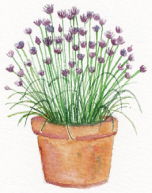

Growing potatoes
Potatoes can be grown in 8in (20cm) pots, potato barrels or thick plastic sacks. It is too late to order special potatoes now (order in October–November for delivery in December–March). This year you could conduct a trial potato-growing experiment, either with those that start sprouting of their own accord in the bottom of the refrigerator, or by buying seed potatoes from a garden centre.
Early morning inspection
This is a most beneficial activity. Before starting work, go on a ‘tour’ of all the window-boxes, tubs and pots and see what has happened since you last looked. It is not only we who are busy. New developments take place during the day and night: two leaves have suddenly become three. The bent-over stems of chives are straightening, their tips still weighed down by minute seed coats. Nasturtiums’ furled-umbrella leaves are opening. In profile, the sweet peas now resemble meerkats. Tomato stems are furrier, their ‘haloes’ thickening. The cucumber’s third leaf has serrated saw-tooth edges.
It is surely better for the eyes to see and be nourished by these sights than by half-digested horror headlines in the newspapers – those can come later. So can another inspection.
Revisiting the wormery
By now the worms will have settled down and be munching, mating, and producing eggs, worm casts (manure) and liquid manure. The best moment to see them is at feeding time, when the lid is lifted and they are caught unawares: tunnelling through bean-pod interiors, massed together in a worm scrum, gambolling, turning somersaults and being generally playful … until they sense the light and within seconds have disappeared, gliding down beneath the compost’s surface. A worm’s whole body can taste and feel both light and sound. What do light and sound taste and feel like? Are they cool or warm, sweet or savoury? Sometimes, after heavy rain, a few of the younger worms may be found wandering around the lid area. If gently lifted, potential escapees can be returned to the clan. It is surprising how lively they can be, wriggling and squirming like the most wilful child – and all without arms or legs.
‘So I went into the garden and ate three worms, two smooth ones and a hairy one; the hairy one tickled all the way down.’
Hilaire Belloc (1870–1953)
They can also be quite skittish and coy at times, playing hide-and-seek by popping up and down out of the compost. A lot of life goes on beneath a wormery lid.
‘A round little worm pricked from the lazy finger of a maid.’
William Shakespeare (1564–1616), Romeo and Juliet
Idle worms: it was once supposed that little worms were bred in the fingers of idle servants.
Reproduction
As worms are hermaphrodites they have both ovaries and testes, and during reproduction produce both eggs and sperm to fertilize the eggs. When mating, they lie side by side, facing in opposite directions, joined by a mucus-like substance that is produced by the clitellum. (This is the swollen band, sometimes called the ‘saddle’ or ‘girdle’, like a plump pink wedding ring, situated on the thirteenth segment about one-third of the distance between head and tail. It is quite easy to see and indicates that the worm is sexually mature.) Sperm passes from worm to worm. Later, a cocoon forms in the clitellum of each worm. Before the cocoons harden, the worms wriggle out backwards. As they do so, sperm and eggs are deposited in the cocoons as they pass over the openings of the ovaries and sperm storage sacs. When the cocoons are released from the worms (they drop off the ends, where the worms’ ‘noses’ should be) they close up at both ends and egg fertilization takes place inside. A worm cocoon is about the size of a grain of wheat, lemon shaped, a translucent yellow-green in colour and could be mistaken for a tomato pip.
After a couple of weeks one or two baby worms will hatch from one end of the cocoon. After a year the babies will be fully grown.
When touched, some young slim worms behave in a most unwormlike way. Suddenly these burrowers and gliders become like watch springs released from their cases, twisting, turning, coiling and uncoiling, sometimes millimetres above the ground.
Planting beans
This is the time for sowing one of the most dramatic of germinators: beans. Dwarf French beans can be sown outside in May and runners from May to June, but they can also be sown inside now, where they can be observed more closely. Either plant runner beans in saved-up toilet-roll interiors or in deepish (3in or 7.5cm at least) saved-up plastic containers. Make a hole with your finger, about 1½in (4cm) deep (see the packet instructions), and place the bean inside, with its scar facing downwards. This is the point from which the root emerges. If placed the right way up (or, rather, down) to begin with, it saves the bean from having to swivel round.
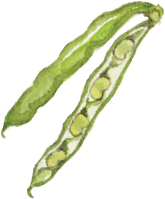
As well as window-boxes, pots and tubs, hanging baskets make good receptacles for vegetables. Don’t line them with that hideous, faded-green padded plastic or the equally unattractive and quickly disintegrating carpet underlay or old doormat fibre, but with moss, which can be bought in packets. One of its main advantages is the pleasure to be had from laying it out in the basket: it is the closest most of us will come to knowing what it is like to make a nest. Admittedly, after a short time and despite watering, its mossy greenness disappears and it becomes straggly and lacy. Hanging baskets are filled with the same compost that is used for window-boxes and pots. Any of the smaller vegetables will grow quite comfortably in them. Mine have been inhabited by alpine strawberries and a ‘herb grove’: three rows of bush basil (bushy with tiny leaves) at one end, three rows of sweet basil (larger leaves) at the other, separated by two rows of dill. Earlier in the year huge bouquets of frizzy endive dwarfed the baskets.
A favourite aversion
Something that I particularly enjoy disliking at the moment is the proliferation of those fashionable, sarcophagi-shaped containers. Usually they are made of very matt metal, highly glazed ceramic or icy-to-the-touch aluminium and are battleship grey, navy blue, black or some other cheerful colour. Although they probably have sufficient soil to support a mini apple tree, normally all they contain is a painfully pruned (from a distance resembling a tight perm or crew cut) gloomy green, spherical blob of box.
Why do people like, or why are they persuaded that they like, these strict, straight-sided, proportionally absurd containers? The box plants live or, rather, survive in solitary confinement in these vertical mini coffins. They are advertised as low-maintenance plants, i.e. needing minimum care and little water – the latter probably because there is not much difference in appearance between when they are dead or alive. In other words, why bother to have a plant at all? When will low-maintenance pets, partners and children be available?
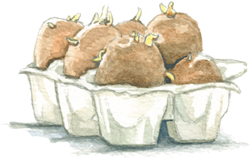
Potatoes should be happily chitting away in their eggbox, their shoots growing longer and sturdier. No matter when Easter is, I like to plant them on Good Friday, when the Devil is supposed to be busy elsewhere.
Sunshine outings
As soon as the sun comes out, load all the different seed containers and seedlings on to trays and take them outside. When it becomes cooler and darker, return them to the window-ledge shelf.
Sixth parsley check
By now the seedlings should be ready to transplant into one of the pots, tubs or window-boxes. Unless you have become a serious eater of parsley, or a specialist, there is no need to plant them in window-box rows – just here and there between other plants.
Don’t bother with a trowel when transplanting seedlings into containers. The soil is friable and hands are more malleable than tools – and it is more enjoyable to touch the plants. Burrow a comfortable-looking hole into the soil, about the size of the parsley container, then put in the seedling, firming the soil until it looks secure and the stem is straight. Water and leave.
Next morning check to see that the seedling hasn’t been blown over, or is keeling over because of thirst or not having been planted deep enough.
The first night out
By now the other seedlings will have done a lot of to-ing and fro-ing on their stretcher-trays between indoors and out. As soon as a warmish evening feels imminent, they can spend their first night out to complete the acclimatization. At this stage in their life they should be able to stand up to a gentle watering from above from a watering can with a fine rose.
This is hardly necessary, as beans make such a soundless commotion when germinating that even the most unobservant seed sower couldn’t fail to notice that something is happening.
The first time I grew beans I couldn’t understand why each morning a little compost was scattered on the window ledge beside the container. Had wind blown it there? Or were the cats testing the compost as an alternative to litter? Day by day the compost disturbance increased. What was taking place was more of an upheaval than germination, as the beans pushed upwards, hardly able to wait to emerge from the compost. (Some seeds are even capable of pushing up asphalt and concrete.)
Final parsley check: reaping what has been sown
Apart from thinning the seedlings during pricking out, no real tasting has yet taken place. Since then the stems have thickened, lengthened and filled with more sap, while the leaves have broadened and multiplied. To reap what one has sown is a triumphant moment. And the more you pick, the more the parsley will grow.
No matter how much parsley is sown, there is never enough. Sow more.
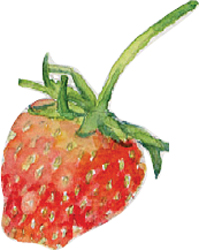
Strawberry propagation
Strawberry runners (those long trailing stems coming from the main plant and tipped with a small clump of bright leaves) are not so easy to propagate when grown in tubs or window-boxes, as there is not enough space. But if you create a halfway house, a type of kindergarten container, propagation is possible.
When the runners start running, fill a container approximately 12in (30cm) in diameter and 5in (13cm) deep with compost, and support it on an upturned bucket or something similar about 12–20in (30–50cm) below the container where the parent plant lives. Now wait for the runners to lower themselves down to the new container. When they have reached just a couple of centimetres below their destination, make a small indentation in the compost. Gently press in the base of the leaf tufts but don’t smother them. This is where the new roots will come from. With a hairpin or homemade hairpin-shaped piece of bent wire, secure them in the compost about ¾in (2cm) away from the leaves. Do not, yet, sever either the main umbilical cord attaching the young strawberry to the parent plant or the secondary potential propagating runner. After a short time, new leaves will emerge from the secured offspring. Now the umbilical cord can be cut a couple of centimetres above the new leaves. A new strawberry plant begins its life. Endless plants can be propagated from the runners and the runners’ runners.
 Seeds to sow now, indoors
Seeds to sow now, indoors
Dwarf French bean (Phaseolus vulgaris) – ‘Sprite’ is good
Runner bean (Phaseolus coccineus) ‘Scarlet Emperor’
Cucumber (Cucumis sativus) ‘Simpson’s Sweet Success’
Dill (Anethum graveolens)
 Seeds to sow now, outdoors
Seeds to sow now, outdoors
American land cress (Barbarea verna) – or save for
August sowing
Komatsuna – or save for September sowing
Lettuce (Lactuca sativa) ‘Black Seeded Simpson’
Rocket (Eruca versicaria subsp. sativa)
Oriental saladini
Vegetable amaranth (dark-grey caviar-like seeds) Iceland poppy
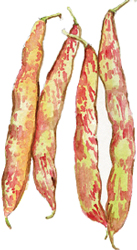
WHAT TO EAT NOW
Cold chicken consommé with sour cream and black lumpfish ‘caviar’
1 x 400ml tin of the best chicken consommé you can find, preferably organic
1 small carton (approx. 200ml) of sour cream or crème fraîche
1 small jar (approx. 200ml) of black lumpfish caviar
small handful of dill or tarragon
Put the tin of consommé into the refrigerator until almost solid. Then divide between two soup bowls. Top with a generous helping of sour cream, lumpfish and finely chopped herbs. Eat the consommé while still in its jelly-ish state. Don’t wait until it has liquefied.
